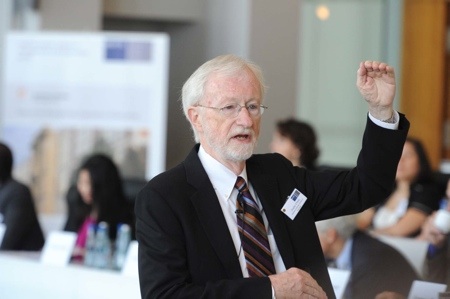
As O’Reilly puts it, the aim of the program is to “help leaders understand how to compete successfully in mature and emerging businesses and to really drive change in their organizations.” He adds, “We give people a set of skills that help them be better in terms of influencing and getting things done in the organization and how to scale this change.”
Burgelman turns to face his audience and starts with an example from Intel, a company he has studied for decades. A master teacher, he gets everyone charged up in no time. “If you are the customer, which is the computer maker, and your supplier wants to do something that you do, will that make you happy?” he asks. Heads bob up and down. The answer is clearly a resounding no.
“So I need access to customers through the sales people in the organization. But the sales people won’t be too happy either,” he continues, and everyone suggests possible solutions.
“To do this, I will get those kinds of people in my team who have good relationships with the sales people,” adds Burgelman. “In other words, I will get people onto my team, or the green process, who have access to people who control resources and are in the blue process.” He uses examples from companies like Intel, Disney and Pixar, Kodak and digital cameras, to show how this conflict between the blue and green comes into play and how it can possibly be dealt with.
The LCOR, an unusual joint program between Stanford and Harvard, has run for nearly 25 years now. Each year, one iteration of the program is held at Stanford, a second one at Harvard, and a third one is held at either of the two campuses by rotation. O’Reilly spearheads the program at Stanford, while his long-time friend and co-author Michael Tushman does the same at Harvard. All the participants are from senior levels of management – board members, presidents, chief executives, and vice-presidents. Interestingly, nearly a third of the 59 participants are above the age of 50. While is mostly taught by Stanford and Harvard faculty, the LCOR sometimes brings in guest speakers from industry. “Last year we had the chairman of JetBlue Airways talk about how he, as a leader at Jetblue, created a culture of trust,” says O’Reilly.
Over the last 25 years, the LCOR has undergone few changes. “The basic idea of change being a function of strategic insight and strategic execution is the same but the knowledge that we have, the richness of what we know about those two components has gotten much better,” says O’Reilly. That has led to new components such as a design-thinking exercise which takes place at the Hasso Plattner Institute of Design.
Unleashing Creativity
During the afternoon session, the decibel levels in Studio Two are high. A rather odd-looking carved deer head peers down from one of the walls at the participants who are sitting in groups of four on tall narrow tables that give each person little room for maneuver and virtually no privacy. Excited chatter fills the room as everyone waits for instructors Perry Klebahn and Jeremy Utley to tell them what to do.
“We have set you too close to each other on purpose,” says Klebahn whose voice rises above the din. “Innovation doesn’t happen if you are too comfortable.”
Klebahn, an associate professor at Stanford’s design school, gives the executives a quick overview of design thinking before launching into the exercise. “As leaders we teach innovation as a process,” says Klebahn, who has worked at companies like Patagonia and Timbuk2. “It’s not a process but a series of mindsets.” That comes from adopting some attributes, he explains, like show not tell, a focus on human values, the notion to embrace experimentation, and to create clarity from complexity.





Questions about this article? Email us or leave a comment below.